Mulching vegetables allows you to save water in the garden while improving soil quality and helping your vegetables grow. You can use leftovers that accumulate in the garden anyway.
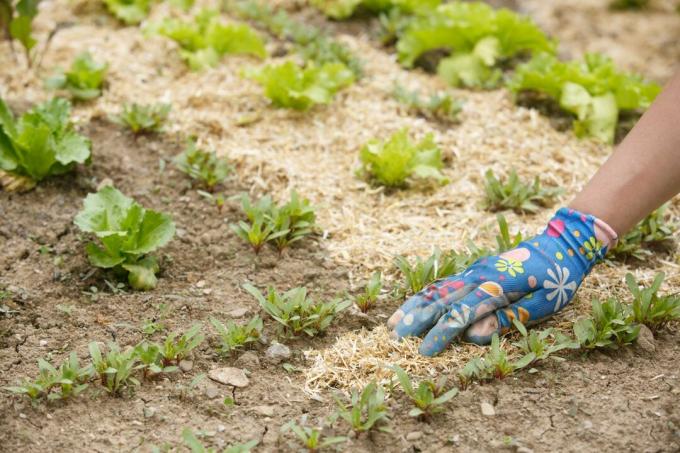
In contrast to vegetable beds, you will not find bare earth in nature, because it would be vulnerable to all elements. The sun quickly heats up and dries out the soil, the wind wears away more and more soil, and rain creates thick, brown crusts. These are less permeable to air and over time they drain rather than absorb water. Nature protects itself from this by quickly colonizing such spots with plants of all kinds. In the garden, however, one is more bothered by the “weeds” sprouting everywhere. So by mulching you kill two birds with one stone. There will be no more vacancies in your garden and at the same time the growth of unwanted plants will be suppressed.
contents
- Should you mulch vegetable beds?
- Which Vegetables Benefit From Mulch?
-
Which mulch is suitable for the vegetable patch?
- lawn clippings and grasses
- straw
- nettles
- sheep wool
- compost
- mulch film
- Instructions for mulching
Should you mulch vegetable beds?
There are a number of benefits to mulching vegetables in the garden.
- The risk of erosion is reduced. Wind and rain can no longer erode the soil so easily.
- The evaporation and thus the water loss of the substrate are reduced. So you have to water significantly less.
- Temperature fluctuations in the soil are smaller because a layer of mulch shades and cools the subsoil in summer, but insulates and warms it in winter.
- Many wild herbs that belong to the light germination count, but not the light stimulus required for their germination. That is why significantly fewer weeds germinate in properly mulched vegetable beds.
- If you use organic mulch material, this brings other advantages. It provides food for microorganisms and promotes healthy soil life and the formation of humus. This also improves the soil structure. Depending on the mulch material, important nutrients for plants are also released. This allows a lower use of fertilizer.
- Garden leftovers such as lawn clippings can be used sensibly. This closes the cycle of materials in your own garden.
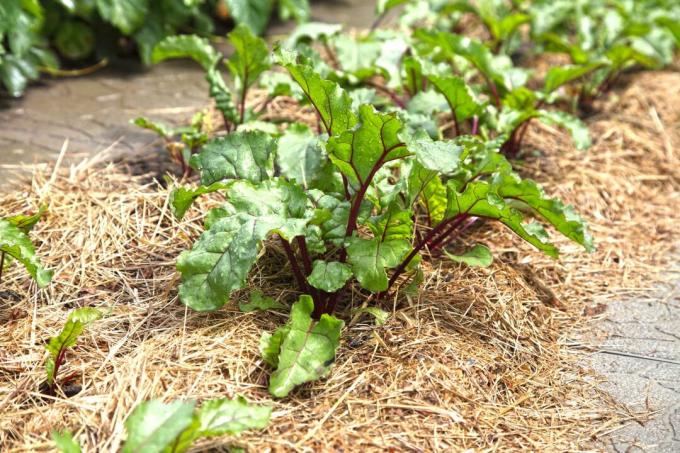
Mistakes in particular can cause more problems than can be solved when mulching in the vegetable garden. Some disadvantages of mulching are:
- Depending on the mulch material, more weed seeds can get into the bed.
- When material that is difficult to decompose, such as bark mulch or straw, decomposes, nutrients can even be extracted from the soil.
- Mulch layers that are too thick sometimes start to rot. The mulch layer and the underlying soil do not get enough oxygen, which affects healthy soil life. On the other hand, many pathogens like some molds feel very comfortable in these conditions.
- In some mulch materials such as lawn clippings, the conditions are ideal for snails. This can lead to a veritable plague of snails.
- Mulching significantly limits the options for soil cultivation: weeds, which are The layer of mulch that creates can only be torn out and the application of seeds or granulated fertilizers is no longer the case quite possible.
- Tender seedlings and young plants are more likely to be inhibited than encouraged in their growth by mulch.
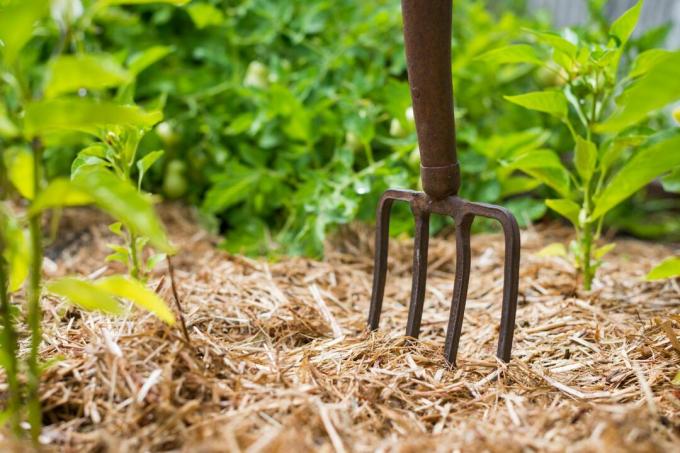
Which Vegetables Benefit From Mulch?
Warmth-loving plants that need a lot of water and do not shade the soil so much benefit in a special way from mulch. These include cucumbers (Cucumis sativus), paprika (capsicum), eggplants (Solanum melongena) and tomatoes (Solanum lycopersicum). Here, mulch also prevents raindrops from bouncing off the ground and reaching the plants, a possible route of infection for the dreaded late blight (Phytophthora infestans) is. Even between boys cabbages (Brassica) a mulch layer makes sense. Later, they shade the ground themselves with their large leaves and mulching is no longer necessary.
For plants with ground-level harvesting organs, mulch prevents fruit from lying directly on the ground and getting dirty. For example, the mulching of zucchini (Cucurbita pepo subsp. pepo convar. giromontiina) and strawberries (Fragaria) sensible.
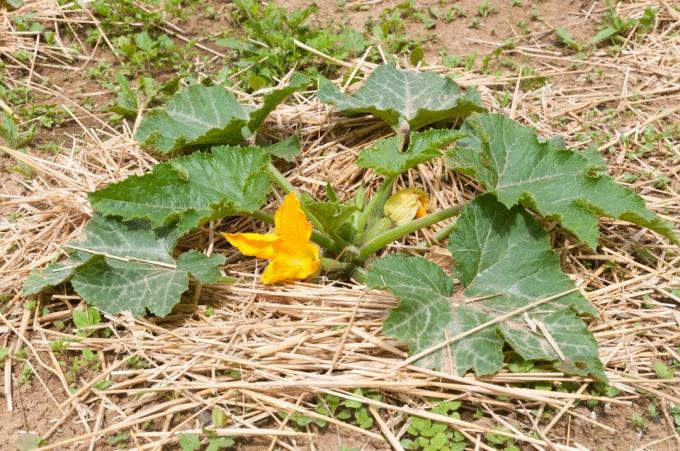
For plants with a short cultivation period such as radish (Raphanus sativus var. sativus) short, fine mulch that is applied thinly is more suitable. Plants that stay longer on the bed can also be well mulched with coarser material such as straw.
While mulching generally has many benefits, there are some plants that should not be mulched. These are mainly plants that come from the Mediterranean region or from steppes and savannas. Many of them require a dry and warm soil and therefore do not tolerate a moisture-retaining mulch layer. These include garden herbs such as thyme (Thymus vulgaris), sage (Salvia), rosemary (Rosmarinus officinalis) and lavender (Lavandula angustifolia).
Also at onions (Allium cepa) you should be a little more careful when mulching. Drought is a signal for onions to move the contents of the leaves into the tuber and let the herb die off. If it is damp for too long in summer, this does not happen and onions either start to rot directly in the field or are difficult to store.
Mulching vegetables that snails like to visit can also prove to be a mistake in some gardens: Because some types of mulch, such as thickly spread straw or grass, offer the annoying pests an ideal habitat.
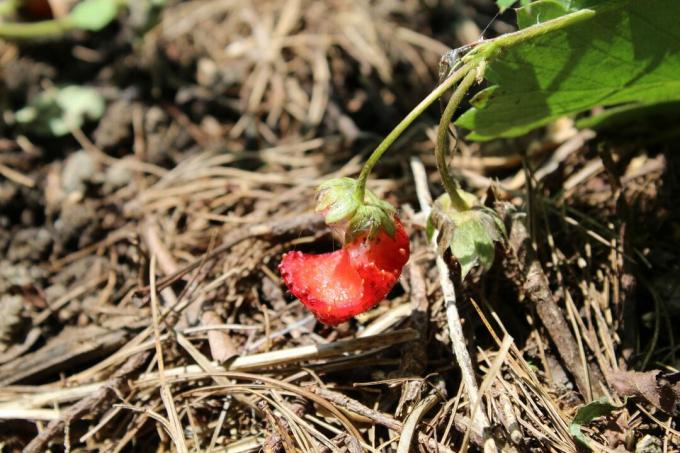
Which mulch is suitable for the vegetable patch?
With the large selection of possible mulch materials the question of which mulch is good for vegetable beds is not easy to answer. It also depends on which materials are used in your own garden and what can be easily integrated into existing gardening practices. We have put together a small list of mulch materials that are particularly suitable for vegetable beds and raised beds.
lawn clippings and grasses
Grass clippings are ideal for mulching vegetable beds. It is cheap and usually plentiful during the growing season. It is also relatively fine and contains a lot of nitrogen, so it can be quickly metabolized by soil organisms. However, you should definitely let the grass clippings dry before spreading. Otherwise it can happen that damp mats form that start to rot. In addition, it is better to spread a thin layer of a few centimeters and to renew it regularly when you see the soil again, that is, every 1 to 2 weeks. This allows the material to dry properly and the entire mulch layer does not become too thick as old material is broken down while small amounts are added at the top. If you use the cuttings of older grasses, you should make sure that they have not yet formed seeds. Otherwise, they accumulate in the vegetable patch, which tends to aggravate a weed problem rather than solve it.
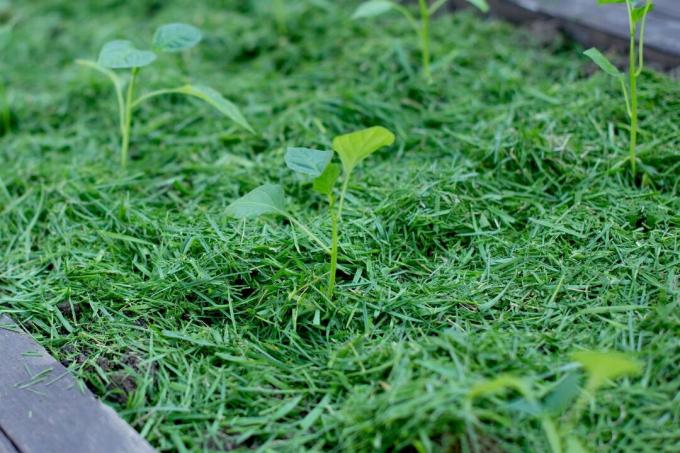
straw
Straw has a coarse structure. It protects the floor, but still allows good air circulation. Disadvantages of straw are its relatively low nitrogen content and the risk that long periods of rain will cause thick mats of straw to form that will begin to rot. In the garden, straw is a good mulch for vegetables that have been cultivated for a long time. For example, you can use it to mulch zucchini, tomatoes, pumpkin, strawberries and peppers. If you use straw as mulch material, you should consider two things in particular:
- Apply straw as mulch at the earliest in mid-April, when the soil has warmed up a bit. Since straw is very light, it reflects light well and the ground underneath only warms up slowly. This can stunt the growth of young plants in particular.
- Straw with its high carbon content is difficult for soil organisms to digest. They need nitrogen for this, which they first extract from the soil. This can initially lead to a decrease in plant-available nitrogen. Therefore, before spreading the straw, you should definitely work some organically emphasized, nitrogenous fertilizer into the soil. For example, ours is well suited for most types of vegetables Plantura organic tomato fertilizer. It's primarily organic and works over time, so you can leave the mulch layer alone for a while. It is also made from plant residues and is therefore completely animal-free.
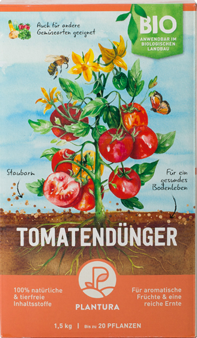
Plantura organic tomato fertilizer
effective long-term effect,
good for the soil, harmless for humans, animals and nature
nettles
nettles (Urtica) are often used to produce a plant liquid manure. If the plants are in large numbers in your garden, they can also serve well as a nitrogen-rich mulch. Nettles rot quite quickly, so you can apply a slightly thicker layer of 5 to 10 cm, provided of course that there are enough nettles in the garden. As with grasses, you should make sure that you only use seed-free parts of the plant with stinging nettles. Stinging nettles can be crushed before spreading for faster implementation.
sheep wool
Wool is essentially fertilizer and mulch in one. For a long time, wool was far too valuable to be used in the garden. However, this has changed in recent decades, so that some wool has even been classified as waste. By using wool, you are not only doing something good for your garden, you are also supporting shepherds in your area. The advantages of wool are that it stores water relatively well, but is avoided by snails and is relatively rich in nitrogen. In addition, it has a temperature-regulating effect.
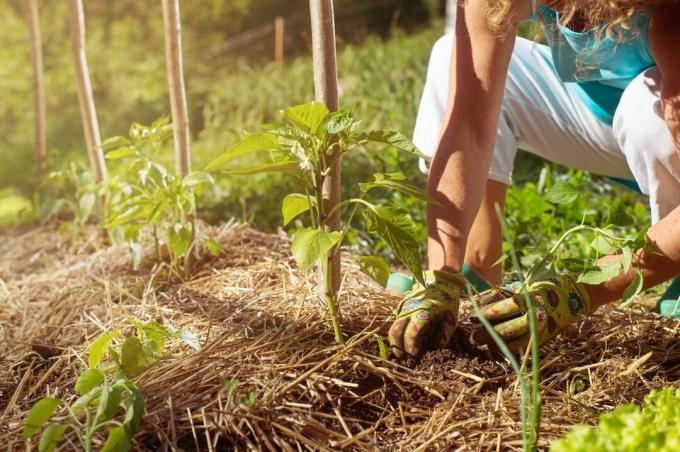
compost
compost is excellent for mulching nutrient-hungry, heavy-consuming vegetables, has a high fertilizer value and an earth-like appearance. However, it should only be used in moderation to avoid over-fertilization. For weak feeder and most herbs, however, compost should not be used as mulch. Mature compost is a good organic supplement to be left on the bed after the growing season is over and incorporated into the soil. For example, unripe compost can be spread on empty beds in the fall. It covers the subsoil during the winter and is already being decomposed a little, so that humus and nutrient enrichment occurs in the soil at the same time. In summer, however, the cooling and evaporation-protecting effect of compost is less than that of some other mulch materials. In addition, diseases and weed seeds can be spread throughout the garden via compost, because mostly When composting at home, the temperature does not rise high enough to contain pathogens and weed seeds to kill.
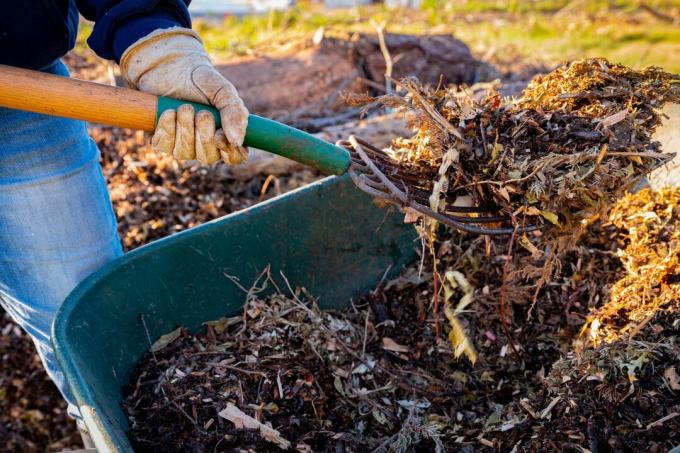
mulch film
The advantages of a mulch film are almost complete weed suppression, clean vegetables and less water evaporation. Under black mulch films, the soil also warms up faster in spring. However, mulch films are mostly made of plastic. This means that they do not rot and are therefore of no use to the soil organisms and the soil structure. In addition, they must be removed from the beds every autumn and regularly disposed of and procured again. In addition, plastic becomes brittle when exposed to UV radiation. So it often happens that larger and smaller scraps are distributed in the garden and the environment. This creates micro and macro plastic, which is only broken down very slowly. However, mulch films are often used in commercial vegetable cultivation because they significantly reduce the amount of work involved in caring for vegetables. In the meantime, however, there are also foils that remain on the beds in autumn and are slowly decomposed in the soil.
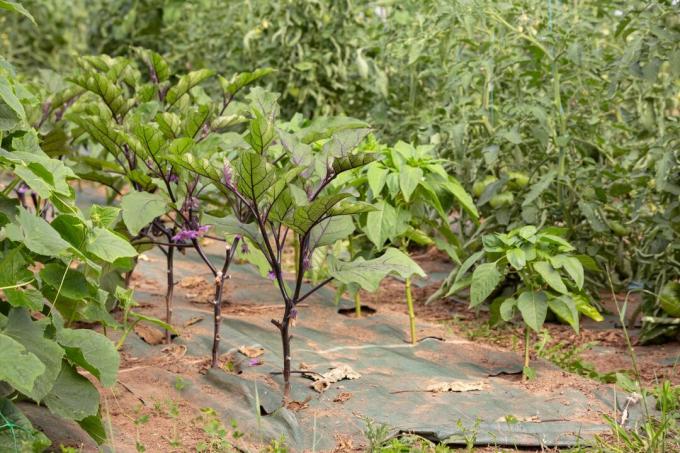
Tip: Bringing bark mulch into the vegetable patch is less suitable, because it contains little nitrogen but many carbon compounds that are difficult to break down. It also has a pH that is too low for many types of vegetables. So bark mulch in the vegetable patch slowly decomposes, depriving the soil of nutrients and worsening the growing conditions for many types of vegetables. Nevertheless, bark mulch can be used in the vegetable patch. For example, paths in the vegetable patch made of pine bark not only look beautiful, they also last a long time and suppress weeds. Ours is well suited for this Plantura organic pine bark. It is sustainably manufactured in the EU and is less polluted than conventional bark mulch.
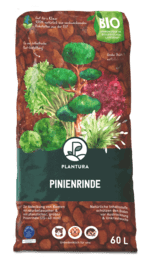
Plantura organic pine bark
Decorative & natural pine bark
in coarse structure from 25 to 40 mm,
protects against weed growth and dehydration
Instructions for mulching
In principle, mulching of vegetable beds is possible from spring to autumn. However, after sowing or planting, wait some time before mulching vegetables. In this way, it can already grow a few centimeters and is not shaded by the mulch material or directly eaten by any snails that may have been attracted.
When mulching vegetables, you can use the following steps as a guide:
- Prepare the soil by thoroughly weeding and raking. In the case of mulch materials that are difficult to decompose, such as straw, an organic, nitrogen-containing long-term fertilizer such as ours should also be used Plantura organic tomato fertilizer be incorporated.
- If the soil is dry, you should water the beds thoroughly again before mulching.
- Then the mulch can be applied loosely. How thick depends on what material you are using. Lawn clippings should only be applied thinly, i.e. a maximum of about 2 cm thick. With straw, wool, nettles and compost, on the other hand, it may be 5 - 10 cm.
- You can actually leave the beds to themselves afterwards. However, the mulch layer should be checked regularly. If some weeds manage to grow through the mulch, they must be plucked out. If the mulch sags and begins to smell foul, it should be removed entirely.
- When the mulch thins and most of it is gone, it's time for a new layer of mulch.
Tip: You can also proceed as described above when mulching raised beds and greenhouses. In raised beds, the soil usually dries out particularly quickly, which is why mulch is also very useful there.
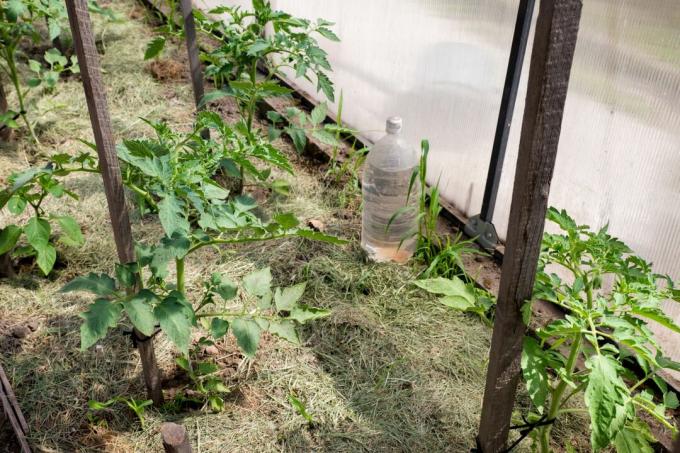
The approaches to mulching are further developed and implemented in permaculture. Thinking in cycles, conserving resources, building humus and saving water are just a few of the goals of this sustainable garden practice. What is permaculture, we will explain in more detail in a separate article.
...and receive concentrated plant knowledge and inspiration directly in your e-mail inbox every Sunday!


